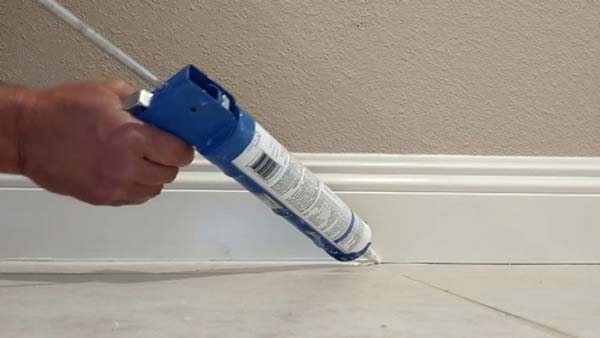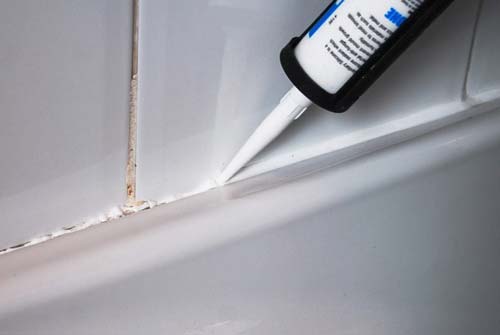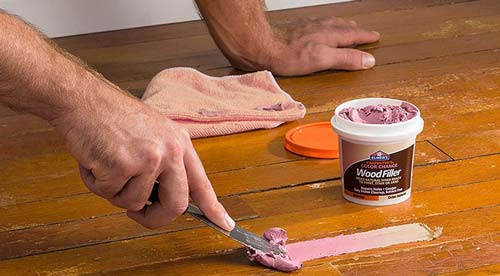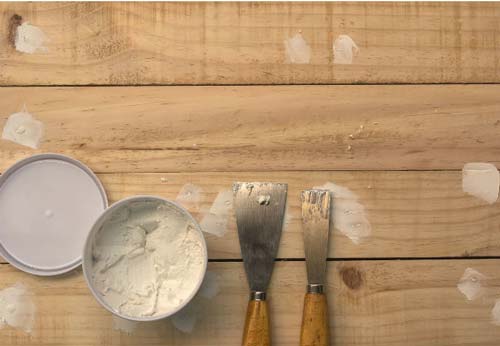Fixing those tiny holes or gaps you see around your house may not be the most exciting thing you can think of right now. However, once it’s done, you will be the one staring at the redone surface with a smile!
To complete the task, you will need proper fillers and sealants according to the material and texture of the affected area. Two of the most popular choices in this regard are caulk and wood filler. It might confuse many people as to how they really differ from each other.
And we are here to answer just that! Let’s see how the comparison of caulk vs wood filler shows us!
Table of Contents
What Is Caulk?
Caulk refers to the material you can use to fill or seal the gaps between two surfaces.
Even though it was initially used for the maintenance of wooden boats or cast iron pipes, now caulk is typically used in bathrooms where the surrounding surfaces tend to be damp almost all the time. As a result, they need to be protected against leakage and the resulting water damages with the help of caulking.

You will usually find it available in one of the two materials – either silicone or acrylic. Both of them come with their individual sets of pros and cons, as we will discover soon. Other varieties of caulk include vinyl latex, polyurethane, and polysulfide.
Advantages of Caulk
1. Energy Conservation
In this new era where how much energy you spend adds to your accountability as a human being, getting a chance to conserve it is surely a great advantage. Doing so not only saves the environment but also saves you quite some money on the monthly utility bills.
Caulk makes such win-win situations possible by preventing drafts of hot or cold air into and out of your home or office. By hiring a caulking professional, you can rest assured that your HVAC system or furnace will not be overworked again to maintain an optimum temperature inside the house.
2. Protection From Water Damage
Along with saving on your energy bills, caulking can also protect your walls from water damage if you use the right variety. Caulks based on silicone are waterproof. As a result, using it in the water-prone areas of your home or office will protect those spots from water damages.

These areas include spaces around the sink, bathtubs, kitchen faucets, and similar spots which are almost always damp or in contact with water. Even if the water accumulated here seems small, it can still damage that space significantly over time by seeping into the cracks and crevices.
So you will need to caulk these areas on time to prevent any water from getting into the wrong places. Otherwise, it will eventually start wearing away the floors and walls.
3. Prevents Insects
Nobody appreciates insects invading their spaces – be it home, office or any other places where you need to stay comfortable. Through the tiny cracks present around your home, they still manage to get inside and start building their large community. Don’t let their tiny size fool you!
Among the many ways to prevent such infestation, caulking is one of the fastest and least costly solutions. By sealing or filling up those gaps through caulking, you won’t let them find a way into your home again.
Disadvantages Of Caulk
1. Silicone Caulk Is Not Paintable
Even though it provides strong protection against leakage and water damage, the silicone caulk can get you into some trouble related to aesthetics. This variety of caulk cannot be painted over and thus you will have to bear with the original color stain on your bathroom wall.
2. Cannot Be Sanded
Caulk comes at a pretty economical price point and placing it within the gaps is quite easy. However, it has to be done very carefully and neatly so that it doesn’t need to be polished over anymore. This is because caulk cannot be sanded which is usually a vital finishing touch in such tasks.
What Is Wood Filler?
As you can guess from the name, a wood filler is a substance that professionals use to fill up holes in the wood. It tends to become quite hard after drying but ensures a smooth surface on the repaired area. Each wood filler usually consists of the combination of a filling substance and a binding agent.
Even though most of them may not match the original color of your surface perfectly, the wood fillers of professional grades do let you choose from a wider variety of shades. To make a seamless filling with a similar texture, you can take some sawdust from the project and mix it with the product.
Many consider wood fillers and wood putties to be the same thing. However, they are actually quite different in terms of ingredients and applications. Wood fillers are water-based, sandable, and not meant for outdoor use, whereas wood putties are oil-based, not sandable, and weatherproof.
Advantages of Wood Filler
1. Dries Fast
Applying wood filler to the holes will not take much time and we all know how important saving time is in today’s fast-moving world. Wood fillers take no time in drying and making the spots ready for sanding. It will get dry and hard within 30 minutes to an hour. Putting it in thin coats will reduce the time even more.
2. Perfect For Filling Holes
Wood fillers are ideal for leveling porous surfaces. Especially when it comes to unfinished lumber, wood fillers tend to perform the best. You might need to apply the product in several coats for filling up the holes. It can fill up holes of any size – be it as minuscule as a grain or much larger and more conspicuous.
3. Adjustable Consistency

You can change the consistency of a wood filler according to your requirements for the particular project. It can be as thick as a wood putty or as thin as a pancake batter. The first consistency is mainly used for filling up voids while the second one is more suitable for filling up tiny pores.
4. Sandable And Paintable
When you are applying the wood filler on a porous surface indoors, you don’t have to worry much about not making it smooth right away. That is because wood fillers can be sanded and painted over. As a result, you can fix the uneven spots easily with sanding and then match their color with the rest through painting.
Disadvantages of Wood Filler
1. Not For Filling Gaps In Trim
While it is not impossible to fill up gaps in trim with wood fillers, we would not recommend doing so. The whole process will take a long time since you will need to apply the filler into those incredibly narrow spaces and then also sand it. However, if you have the time and the patience, you can try it.
2. Not For Outdoor Use
Even though many of us love the wooden structures outside our house, wood fillers are not meant for outdoor use. It can dry out after coming in contact with direct sunlight and start to shrink over time. As a result, it will not last a very long time and can fall out within a year.
Wood Filler vs Caulk: What are the differences?

1. Applications
Even though they are both used to fill up gaps or holes, caulk and wood filler actually serve two different purposes. While the caulk is meant for filling up gaps in trim, wood filler is better for filling up pores and holes.
To be more specific, caulk is mostly used to fill up inner molding corners or gaps in the trim of baseboard, windows, doors, and other areas. It can also help to seal windows, skylights, around edges of tile work, sinks, bathtubs, and similar fixtures in the bathroom.
On the other hand, wood fillers are used to fill nail holes and outer corners of molding, as well as to fix holes and gouges in wood surfaces.
2. Sanding
Sanding has always been a vital part of restoring wood and making it last a much longer time. Completing this step can extend the lifespan of that wooden fixture or furniture piece. It gets rid of all the scratches and cuts carved on the surface and removes any other imperfection for a smooth plane.
Unfortunately, caulk cannot be sanded and thus you will have to be extra careful while applying it on a trim. In contrast, wood fillers can easily be sanded and provide you a beautifully even surface. You don’t have to stress over any uneven spots you left during the application phase.
3. Painting
While painting a new color can surely revive the appeal of an area, it plays a much bigger role when it comes to repairing a surface. If you can paint over a repairing substance, you can make it invisible to guests by matching its color with the surrounding area.
Wood fillers and acrylic caulk provide you this convenience by letting you paint over them. However, silicone caulk cannot be painted. So using it can lead to some aesthetic inconvenience even though it is very long-lasting.
4. Weatherproof
If you are particularly looking for a repairing solution to apply outdoors, caulk will surely be a much better choice than wood fillers. Especially the silicone caulk can resist water, temperature, chemicals, and weather. It lasts a long time without any deformation and thus makes a great option to protect the surfaces outside.
Wood fillers tend to shrink and expand at rising and lowering temperatures respectively. So they don’t last very long if applied outdoors.
5. Varieties
Both wood filler and caulk come in many varieties. Each variant serves a different purpose. Wood fillers can be water-based or solvent-based, and made of various materials like epoxy or latex. On the other hand, caulk can be made of acrylic, silicone, vinyl latex, polyurethane, and polysulfide.
Final Words
After comparing caulk vs wood filler head-to-head, we can see that both of them have some strong points and weaknesses.
While caulk can be more long-lasting and suitable for outdoor use, it is not sandable and sometimes, not paintable either. In contrast, wood fillers can be both sanded and painted, but cannot be used outdoors. That is why, to get a successful repair session, you will actually need both!
